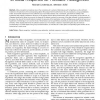Free Online Productivity Tools
i2Speak
i2Symbol
i2OCR
iTex2Img
iWeb2Print
iWeb2Shot
i2Type
iPdf2Split
iPdf2Merge
i2Bopomofo
i2Arabic
i2Style
i2Image
i2PDF
iLatex2Rtf
Sci2ools
ACCV
1995
Springer
1995
Springer
An Integrated Model for Evaluating the Amount of Data Required for Reliable Recognition
—Many recognition procedures rely on the consistency of a subset of data features with a hypothesis as the sufficient evidence to the presence of the corresponding object. We analyze here the performance of such procedures, using a probabilistic model, and provide expressions for the sufficient size of such data subsets, that, if consistent, guarantee the validity of the hypotheses with arbitrary confidence. We focus on 2D objects and the affine transformation class, and provide, for the first time, an integrated model which takes into account the shape of the objects involved, the accuracy of the data collected, the clutter present in the scene, the class of the transformations involved, the accuracy of the localization, and the confidence we would like to have in our hypotheses. Interestingly, it turns out that most of these factors can be quantified cumulatively by one parameter, denoted “effective similarity,” which largely determines the sufficient subset size. The analysis ...
| Added | 25 Aug 2010 |
| Updated | 25 Aug 2010 |
| Type | Conference |
| Year | 1995 |
| Where | ACCV |
| Authors | Michael Lindenbaum |
Comments (0)

